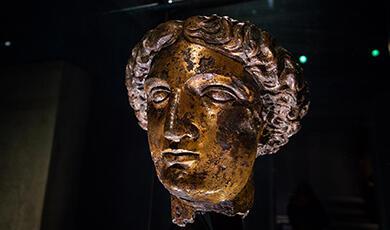Lessons from Guantánamo Bay
Share
- Details
- Text
- Audio
- Downloads
- Extra Reading
This lecture looks at the evolution of Guantánamo Bay, first as a focal point of Haitian immigration in 1991 (Gitmo 1.0), to the more famous detention of terror suspects in 2002 (Gitmo 2.0), and back to immigration in 2025. We will explore how Gitmo 3.0 is probably already over, and how we were able to head it off so quickly through legal challenges. However, Secretary of State Marco Rubio has said the U.S. is “actively searching” for countries to accept migrants deported from the U.S., with both El Salvador and Rwanda under consideration. We will discuss how lessons from legal action around Guantánamo Bay might translate to other settings.
Download Text
LESSONS FROM GUANTÁNAMO BAY
Professor Clive Stafford Smith
18 September 2025
My first lecture of the year looks at Guantánamo Bay, first as a focal point of Haitian immigration in 1991 (Gitmo 1.0), next the more famous detention of terror suspects in 2002 (Gitmo 2.0), and then, under President Donald Trump, back to immigration in 2025 (Gitmo 3.0). The common denominator for each of the three iterations has, of course, been the vilification of a tiny minority who were being held up as the cause of society’s ills. Likewise, in each instance this hatred has been rooted in lies.
On each occasion to date those lies have been quite rapidly exposed. That is not to say that we have won the war: after Gitmo 1.0, the U.S. immigration system was still floundering in racism; the decline of Gitmo 2.0 has seen only a marginal decrease in Twenty-first Century Islamophobia; and even if he lost a skirmish in Gitmo 3.0, Trump has weaponized the hatred of immigrants without regard to his own Scottish roots.
On my forty-two trips to Guantánamo Bay over the past 21 years (it is clearly my Caribbean resort of choice) every time I took the ferry from the airport on the Leeward Side to the main base on the Windward Side, I would come to the ferry landing. This is where Christopher Columbus anchored on his second transatlantic trip, on April 30, 1494. He was in search of El Dorado, but he found nothing of interest in Guantánamo – no water, let alone gold -- and left the next morning. There is really nothing there that is worth the hype.
In 1898, when the U.S. joined into a war with Spain to liberate swathes of Spanish colonies, the U.S. claimed Guantánamo without appearing to notice how inappropriate such an expropriation was. The U.S. wrote its claim into the early law of Cuba Libre, paying a derisory $2,000 in gold each year, rising to $4,085 in 1934, to hang onto a naval base twice the size of Manhattan (and rather less than the average monthly rent of an apartment there - $5,620).
I don’t suppose it is really worth much more, unless we can turn it into a museum to human folly.
* * *
Gitmo 1.0 arose during the Administration of George H.W. Bush – Bush Senior. Unrest in the Haiti in the wake of the overthrow of Baby Doc Duvalier saw thousands of refugees fleeing towards the promise of the Statue of Liberty: “"Give me your tired, your poor, your huddled masses yearning to breathe free…”
Except, of course, that Lady Liberty only meant this to apply to tired white people – and, naturally, the relatively white people fleeing the evils of communism in (ironically) Cuba, who would be welcomed with open arms. If, on the other hand, they were the black descendants of slaves in Haiti, they would be viewed as an invading force. The U.S. “interdicted” them on the “High Seas” before they made it to terra firma, and diverted them to the naval base at Guantánamo. Then the U.S. government of Bush Senior, supposedly the proud promoters of human rights, argued that because the base was not technically U.S. territory, neither the U.S. constitution nor international law could help the Haitians.
In Sale v. Haitian Centers Council, in 1993, eight of the nine justices on the Supreme Court accepted this ridiculous view. A lonely Justice Blackmun, dissenting, noted that the Court could only find this acceptable by announcing that “the word ‘return’ does not mean return, … the opposite of ‘within the United States’ is not outside the United States, and … the official charged with controlling immigration has no role in enforcing an order to control immigration.”
Thus began two Guantánamo traditions: one, trying to prevent foreigners from benefitting from the rule of law; and two, contorting the language in order to do so.
* * *
Gitmo 2.0. In the wake of 9/11 and the October 2001 invasion of Afghanistan, George W. Bush (Bush Junior) needed a place to put their captives. Preferably this needed to be somewhere without the irritant of human rights. It was clear that not a lot of the true perpetrators of 9/11 would be put on trial (whether civilian ones, or military commissions) as they had managed to kill themselves while they slaughtered 3,000 innocent civilians. Usama bin Laden was an obvious target, but there were not going to be many people left who had actually had anything to do with what was perhaps the most sensationally publicized crime in history.
There was a phenomenal gut-desire in the U.S. for something that looked like pure revenge, though, and Bush Junior wanted to look tough – even if the targets would have less and less to do with what originally happened. For this to retain a sense of legitimacy, it was important to avoid the emergence of embarrassing truths.
His advisors remembered his father’s experience just ten years earlier.
* * *
When I first heard of the plan to create this prison on Cuban soil over Christmas in 2001, my first thought was that they were mad. Everyone, we were told, could face execution on what was then a rather anonymous military base. What the legal system might be there, nobody knew. This was just another of the Bush Administration’s ill-conceived reactions to 9/11.
My first reaction was that we should immediately sue – what could be more important (and fun) than bringing such a case against Bush? But as I called around my friends in the death penalty community, it became clear that I had woefully underestimated the impact of 9/11 on the American psyche. Compared to most countries, the U.S. has had its territorial integrity impugned on remarkably few occasions – really only the War of 1812, Pearl Harbor on December 7th 1941, and now 9/11. Due to this, feelings were very strong, and nobody wanted to defend the invaders. Eventually, just three of us pulled together the litigation that would become Rasul v. Bush in the U.S. Supreme Court two years later – albeit not until we had experienced solid losses in District Court and the D.C. Circuit.
The prognosis did not look great. Bush was the most powerful person on the planet at the time. The closest analogy we had was the internment of Japanese-Americans in World War Two – and had taken decades for the U.S. to recognize the excesses back then. President Franklin D. Roosevelt's Executive Order 9066 had justified the military interning 110,000 people, and it was President Ronald Reagan who signed eventually the Civil Liberties Act of 1988, more than 40 years later, which included a formal apology and financial reparations of $20,000 to surviving internees.
The closest legal precedent were the trials of the Nazi Saboteurs who tried to infiltrate the U.S. at that time. A German U-Boat maneuvered along the Long Island shoreline and around midnight, on June 13, 1942, some men got into a rubber boat. Four more landed in Florida, buried their explosives, and took a bus to Jacksonville. They were all quickly arrested, but not thanks to the FBI – one of them hated Hitler and went immediately to the police. J. Edgar Hoover did not want this coming out, and FDR said the death penalty seemed to be “obligatory.” So they convened a military commission and one of its first actions was to render most of its proceedings secret. In the finest of American legal traditions, the chief defense counsel, Colonel Kenneth Royall, challenged this as unconstitutional.
Within days, in Ex Parte Quirin, the Supreme Court upheld the use of the commissions without bothering too much with the writ of habeas corpus. Within a few more days, all eight had been sentenced to death. Those who actually turned themselves in were ultimately spared execution, but the other six were all electrocuted over three hours on August 8th.
This history did not bode well for our cause in 2002.
And yet here we are a few years later – the most powerful man on Earth has emphatically lost: 765 of the 780 detainees have left the prison; not a single person has yet been convicted of anything in anything that remotely resembles a legitimate trial, let along been executed for 3,000 murders. Khalid Sheikh Mohammed (KSM), the supposed architect of 9/11, remains alive and well in Camp Five. Bush himself conceded that it was a mistake and ought to be closed.
How did this come about?
* * *
There are many lessons to be learned – that I have learned – from these 20 years of my own legal career.
The Court of Public Opinion is more powerful than the Court of Law. The first is that the law is only a very incidental partner in the litigation for our clients’ freedom. To be sure, we had to depend on the Great Writ of Habeas Corpus to get into the Guantánamo Naval Base. We had to win Rasul v. Bush in the Supreme Court. And yet while a sense of justice played a role in the decision in June 2004, even then a significant contributor to this victory was its fortuitous timing: at the moment the case was pending before an already conservative court, the grotesque pictures of Abu Ghraib emerged from Iraq. We had alleged in our petition that our clients were innocent and had been tortured, and this was graphic evidence that this was potentially true. Even people who deferred to the elected authority of the president had a reason to doubt that Bush should be given carte blanche.
Humour always plays a role as well. When people make extreme legal arguments, it is better to ridicule them than engage on their chosen battleground. We figured out that, while the government insisted our clients should enjoy no legal rights, they accepted that the environmental laws applied to Guantánamo. This meant that the iguanas that ran rampant amidst the rocks were protected: if a soldier kicked one, he might face a $10,000 fine and 10 years in prison. How could it be that he could kick a prisoner with impunity? We argued that our clients should at least have “Equal Rights with Iguanas.”
Some of the lawyers who eventually joined our team were seemed to be unwisely obsessed with the minutiae of the law. Across more than 765 cases, a court order ultimately only resulted in the release of two prisoners: indeed, the D.C. Circuit Court of Appeals soon ruled that a federal judge did not have the power to order release. For some of us, once we got in, our work was guided by the mantra coined by Joe Margulies, another member of our original three-person team. Because the entire purpose of Gitmo 2.0 was to pretend that it was doing something to put an end to terrorism, we had to expose the lie.
“If we open it up to public inspection,” Joe summed it up, “they will close it down.”
The next rule is that we must always engage. Joe and I had signed up to defend people in the Military Commissions. This brought up another principle that is very important. The American Bar Association (ABA) originally took the position that it was unethical to take part in those proceedings, which would later be dubbed “a kangaroo court” by a British justice. But I am not a fan of the boycott. If one does not engage, there is only one story – we are pious and we are not taking part in this sham. But if one engages, there are a hundred stories, and that is the only way to tear such a system down.
In the end, then, most of the prisoners were released through the Court of Public Opinion, rather than the Court of Law. Mostly it came down to figuring out how to embarrass the government.
The next rule is that if it is going to be bad, we are much better of when it is really bad. In many ways, it was easy. First there was the secrecy, patterned on J. Edgar Hoover’s plan for the Nazi Saboteurs. It would not do, here, if pesky lawyers were able to show that most of the prisoners were not the “worst of the worst terrorists in the world,” as advertised by Secretary of Defense Donald Rumsfeld. Thus, the rules were that every word spoken to us was “classified”. We had to hand-write notes (I gave up using a pen decades ago), send our notes by the slow boat to Washington, travel at great expense to the capital city, type the notes up in the “Secure Facility”, whereupon the review team would decide if they were a threat to national security.
Predictably, in the first case (of Birmingham-born Moazzam Begg) I first delivered 33 pages of typed material to them, and they censored every page. I asked why torture was classified. “It reveals the methods and means of our interrogation,” the agent explained. What about Moazzam’s description of how the guards murdered Dilawar, the taxi driver killed in Bagram – was that a “method of interrogation”? He just smirked. Then there were the three pages of Moazzam’s PTSD and other mental suffering. “That would be a violation of his privacy,” the man said, despite my insistence that Moazzam wanted it released.
It was initially frustrating but then, like everything else in Guantánamo, it was an opportunity: I wrote a letter to Tony Blair, captioned “Evidence of torture of a British citizen that your allies don’t want the British people to know.” I wrote two pages of this classified material, and then signed it off with a friendly -Clive, with a note – “anything blacked out of this your friends in Washington want to keep secret.” Naturally the whole document was blacked out except the first and last lines, and I published it on the front page of the British papers. The reader’s imagination being even more fertile than the torturer’s, it caused a scandal far worse than revealing the truth.
The government serves up all the bad media that sinks themselves, if only we are there to report it. Indeed, Guantánamo was not just a legal black hole, it was an irony-free zone. In a “War on Terror” intended to preserve “democracy and the rule of law”, Guantánamo had been chosen because it was supposed that the prisoners would have no legal rights at all. Nobody even seemed to notice the irony of the slogan that welcomed everyone to the base – “Honor Bound to Defend Freedom” – when the military prosecutors were arguing that no prisoner would ever have the right to liberty again. It was all redolent of Arbeit Macht Frei. Indeed, the oblivious approach taken by the U.S. military began with the name. Gitmo 2.0 witnessed the soldiers at “the Base” importing 780 bearded Muslim men, all irrevocably presumed to be members of Al Qaeda (the name means ‘The Base’ in Arabic).
There were stories everywhere one turned. On my first visit to “The Base”, I was astounded by the existence of a Souvenir Shop. Of course there was one! I bought several t-shirts - Taliban Towers: A Five Star Resort, or It Don’t Gitmo Better Than This, and then the old staple, the Guantánamo Golf Course, which became a curiosity at my mother’s club in Suffolk. But then there was the popular Behavior Modification Instructor - Behavior Modification being the preferred euphemism for “torturer”. Still more extraordinary were the onesies I bought that were emblazoned with Future Behavior Modification Instructor.
Another level of irony came with the fact that, while, they were perfectly capable of embarrassing themselves with these tasteless things, a significant element of the Guantánamo experience involved the endless censorship of other things. I often warned the journalists who came to the base that what I termed the “Propaganda Tour” was only what the authorities wanted them to see, and I would issue them with a list of requests that I knew the Admiral would refuse. Some were just foolish: a slightly inebriated PR officer bemoaned to me over a few drinks on New Years Eve that he had gone on line and, within ten minutes, found pictures of all the views of the base that the media were not allowed to take.
We must be proactive in helping to prompt the government’s folly. One journalist wanted to interview a prisoner, and that was never going to happen. The Admiral would piously intone that he must respect the “detainee’s Geneva Convention right not to be humiliated in the media.” So I gave the journalist a signed waiver from one of my client, saying he would forego his right and talk to the media. She whipped it out when the Admiral recited his lines. All he could think to say was, “Nice try!”
Yet the censorship went much deeper, and was even more absurd. Our job was to keep pressing the boundaries rather than accept it. We would take in magazines for the clients, and keep a record of what attracted the solid stamp DENIED. These included National Geographic, Scientific American and Runner’s World. Since the second largest landmine field in the world runs between the base and Cuba, I would not want to try running for it.
Puss in Boots, Cinderella, Jack And the Beanstalk and Beauty and the Beast, all got banned. Could it be, I wondered, that Cinderella was actually an Enemy Combatant? Or would the magic bean be a way to escape? I had some stickers done up that said “Banned in Guantánamo Bay” for the books we got censored.
Always remember the power of celebrity. I have worked with many famous people over the years. Some of them are delightfully modest, but it is a modesty we must overcome. If I do something, a small number of people will notice. If John Grisham does it, many more will learn about it. I knew John from other issues – he has always been a solid supporter of the various innocence projects around the U.S. – and he signed a copy of The Innocent Man for my client Shaker, who was a bit of a fan. Naturally, because it talked about the possibility of someone being innocent, it was banned. This allowed John to write an OpEd in the New York Times, reaching millions.
Exposing Hypocrisy is as powerful as their use of Hatred. Everywhere I turned there was another embarrassment for the establishment. There were a few refugees who had struggled around the coast from Communist Cuba in a dingy. They were treated with authoritarian hypocrisy. One man had been locked down for 30 days for the heinous offense of possessing a copy of Playboy. It was not for me to justify his offence, but I did write about Channel 29 and the helping of porn doled out to the soldiers each evening. One night it advertised: The Best Sex Ever (Hearts on Fire); Sex Games (Scents and Sensibilities); Sex Spa II – Body Words; Hotel Erotica; and, Emmanuelle In Space.
The hypocrisy of their racism backfired on them too. The military has adopted various duplicitous tactics. They told the prisoners that all of their lawyers were Jewish, relying on perceived Muslim prejudices to drive a wedge between us.
“So you’re Jewish,” says my client, Shaker Aamer, with some accusation in his voice as soon as I enter the visitation cell. I am taken aback. My father didn’t get around to telling me that he was Jewish until I was 37 years old. Technically, in a matrilineal society, it would have to be my mother for me to qualify, but Shaker and I discussed my ethnicity. Ultimately, we agreed that a shared semitic background between the Jew and the Muslim is probably a good thing, and it is the Cornish half of me that he should worry about.
When they lie about their misconduct, it doubles the impact. There was also the phenomenal predilection among the more senior soldiers on the base to lie. Because what they were doing was so thoroughly criminal, and yet they could not admit to it, they had to come up with euphemisms. Each of these became a story that merely highlighted the offences. The “Human Resource Exploitation Manual” was a book that detailed different levels of duress and torture. When they said that nobody got so depressed as to commit suicide, it took us a while to discover that there was no longer such a thing as “suicide” because they were calling it “manipulative self-injurious behaviour.”
"We don't plan on … er … detaining … um … juveniles at Guantánamo further,” the Pentagon spokesperson, Lieutenant Commander Barbara Burfeind, said at one point. The definition of ‘juvenile’ under both U.S. and international law was indisputable: a person accused of a crime that took place when he was under eighteen. This was the rule in the Optional Protocol to the Convention on the Rights of the Child, which the U.S. has signed and which specifically addressed child soldiers. This was the rule of the U.S. Supreme Court. Indeed, the Court had recently banned the death penalty for juveniles -- those under 18 at the time of the original offence.
I found Barbara’s assertion curious because I had a list of 54 people who I understood to have been under the age of 18 when they were originally captured (or abducted). Her promise was very encouraging news for Omar Khadr, a Canadian. He had been just fifteen when he came to Guantánamo. Presumably, he would soon be going home. The months passed by. On March 6th, 2006, more than two years later, I met Omar in the visitation cell in Camp Five. By now he was nineteen years old. He was still in Guantánamo. Indeed, he had been charged in the Military Commissions. The charge sheet against Omar had the dates in clear black ink: he was born on September 19, 1986, and he was seized by the U.S. on July 27, 2002. So he was fifteen years, ten months, and eight days old at that time. Eventually Colonel David McWilliams, a military spokesman in Miami, made it clear that they had simply redefined the legal term “juvenile” to suit their reality: in their lexicon, it meant that you had to be under sixteen today, so if you were captured at the age of ten and then held for six years you were not a juvenile.
There was no solitary confinement in Guantánamo Bay of course. While many of my clients were held in isolation, this had been dubbed an “SCO” (“Single Cell Operation”).
When the men began to go on Hunger Strike to protest their mistreatment, my clients told me that they were being force fed. But this was not true. Because this was an act of “Asymmetric Warfare”, the military chose to subject them to “enteral feeding”.
All of this allowed the military officers to lie with a straight face to the world’s media on a daily basis. It would probably have served their purpose – albeit an illegitimate one – well if we had not methodically exposed each of their falsehoods.
We have to promote positive stories as much as we disparage their disdain. And yet one of my criticisms of the response to right wing populists like Donald Trump is that the Democrats seem capable of little other than to complain. In Britain, with Nigel Farage, it is even worse: Keir Starmer tries to match him, folly for folly. We must, on the other hand, come up with positive alternatives that appeal to a broad range of people. There were many in Gitmo. One involved Ahmed Rabbani, who went on hunger strike for seven years. (What is the longest you have ever gone without food?) Of course, he was “enterally fed”, but he dropped nearly half his body weight. And while he was on strike, he would cook for the detainees who were not. So we gradually liberated, through the censors, all his recipes, and began to compile his Guantánamo Cook Book, with each recipe named after one of the 62 torture methods he had suffered.
Ahmed was also a fine artist, as were a number of other detainees. We got art supplies into them, and I asked him to paint some of the torture that he had gone through. He brought the pictures to one of our meetings, and I knew they would never get past the censors – they were devastating. So I wrote up very detailed descriptions of each one and, since the censorship process was designed by bears of very little brain, these emerged into the daylight. We then got artists to replicate the pictures as precisely as possible (since I had seen them all, I could help).
Language is how we communicate. All this played into another part of our effort to recapture the language. Again, the right wing tends to do this better (on the heated abortion debate in the U.S., “the right to choose” will never prevail over “the right to life”) and we need to turn the tide – albeit with more honesty than the U.S. military. One of Ahmed’s most striking pictures was of him in a ten-foot pit, with a metal grill at the top, and him hanging on tip toes by his wrists. I had not encountered this before working on post-9/11 cases, but I learned that this was excruciating – his shoulders would have been slowly dislocating over several days – and yet the description did not seem bad enough.
Of course, the U.S. government said this was not torture, it was an EIT (“Enhanced Interrogation Technique”). This began my hobby of finding out what other barbarians called the EITs. This particular one was a favourite of the Spanish Inquisition, and they had called it Strappado, so that is what I called it. It was a proud moment when the New York Times used the term. (Naturally, the name of Ahmed’s recipe that involved hanging the meat for hours before cooking it was “Strappado Chicken.”)
Overall, my favourite discovery was the history of waterboarding. The Spanish Inquisition was again more honest – they called it tortura de agua. To the U.S. it was just an Enhanced Interrogation Technique. But then the Gestapo called it Verschärfte Vernehmung which translates as … Enhanced Interrogation.
In the end, everything came down to torture. I had a conversation with a Gitmo lawyer just this week who continued to talk as if these are regular capital cases. They are not – though one principle remains the same: when they are trying our client, we must always look for someone else to put on trial. The Military Commission of Binyam Mohamed was the ultimate lesson in this.
Another rule of Guantánamo was that there are two very distinct consequences of torture: one is where you confess, probably falsely, to being a terrorist yourself, or accuse someone else. That is too bad for you or for them, and for many people it took far too long to right the wrong. But the second is where you confess to something that changes international policy. The most infamous case (far too little discussed) is that of Ibn Sheikh al Libi, who was taken by the CIA to Egypt where he “confessed” that Saddam Hussein was in league with al Qaida on Weapons of Mass Destruction. This torture material was one of the three insubstantial legs of the stool upon which George W. Bush rested his case for the Iraq War. A few months later, 100,000 people had died.
A second such example came in Binyam’s case. He was raised in the U.K., where he learned both about the rule of law, and to be obstinate about his rights. When he was sold to the U.S. for a bounty by the Pakistanis, he refused to talk to them, saying he knew his rights. “You have no rights here,” an American assured him, and the abuse began.
In the end, Binyam ended up being taken to Morocco for 18 months. As with al Libi, the CIA liked to out-source the worst of its crimes. Binyam’s main tormentor was a man who went by the name Marwan.
“You don’t think I’m a man, not with intelligence,” Marwan said, sneering at Binyam. “Show him who’s a man.” He nodded at the other men.
“One of them took the scalpel to my right chest. It was only a small cut. Maybe an inch. At first I just screamed because the pain was just… I was just shocked, I wasn’t expecting… Then they cut my left chest. This time I didn’t want to scream because I knew it was coming.”
Marwan got agitated at this. “Just go ahead,” he said.
“One of them took my penis in his hand and began to make cuts,” Binyam told me, speaking evenly. I asked him whether he was okay to go on telling me these terrible things. He nodded. His voice was still flat as he continued. “He did it once, and they stood still for maybe a minute, watching my reaction. I was in agony, crying, trying desperately to suppress myself, but I was screaming. I remember Marwan seemed to smoke half a cigarette, throw it down, and start another.”
Binyam has no real idea how long this went on for, or even how many times they cut him after that first time. He estimates maybe two hours, and twenty or thirty cuts, but it is no more than a guess. There was blood all over him.
Binyam confessed to being able to build a nuclear bomb. He had seen an article. Apparently one puts ones Uranium in a bucket, before swinging it around your head for 45 minutes, whereupon – Bob’s your uncle! – it is neatly divided into Uranium-235 and Uranium-239, from which you sort your weapons-grade. It was utter nonsense. I googled it and found there was, indeed, such an article from the 1970s, a spoof written by a journalist in a magazine. She was in a retirement home, but her daughter, a journalist with the LA Times, wrote an article about how her mum had spawned the nuclear attack on the U.S.
The prosecution began by seeking the death penalty against Binyam. There were two tough prosecutors on the case – Colonel Morris Davis and Lt. Col. Darrell Vanderveld. They seemed like true believers. Along with my co-counsel and Mohamed, we took it all as the joke it was. We violated every precept in the death penalty defense manual. We set Binyam loose on the courtroom, to inflict his wonderful British sense of humour on them. We ridiculed whatever rules they had. But we steadily revealed the horrors of what had been done to him. In other words, we ignored what they said he had done, and put them on trial in front of the world’s media.
They dropped death to life; then life to 20 years; then they offered to let him go after one more day if he pled guilty. So we said he’d rather just go free. And he did.
The best witnesses are those who have walked the Road to Damascus. But the most significant thing in all of this was that first Darrell Vanderveld, and then Mo Davis, quit their jobs and took a very public stand against all this torture. It matters less what some lefty like me says, than when a hard-bitten military prosecutor announces that this is just not what America is all about.
* * *
Gitmo 3.0. I had just got the last of my 87 clients out of Gitmo in January 2025, when Donald Trump reappeared, and immediately promised me another 30,000 clients. This time, once again, they were to be the hated class of immigrants.
I was pretty pleased to be back in the business, and was immediately onto my colleagues, urging the Guantánamo Bar to ride again. But it proved short lived – at least initially. His legal advisors had failed to notice one significant difference between his foray into illegality, and those of Bush I and Bush II: the Haitian refugees in the 1990s, and the “Terrorists” of Gitmo 2.0 had both come from abroad, without touching down in America, fitting the foolish, but nevertheless precedential, notion that they had no rights. Trump’s “Immigrant Terrorists” were all flown from U.S. soil to Guantánamo, meaning that they carried their legal rights with them.
While he made much of his first plane load of “Venezuelan Gang Members” to Guantánamo, they all disappeared off home very quickly because it became clear that the Administration had just created a plethora of legal issues that would be difficult for even the stacked Supreme Court to ignore.
We will see what comes of this. Trump is not known for respecting the legal advice of his lawyers and perhaps I will make a fiftieth trip to Guantánamo yet. But I doubt it. A souffle does not often rise twice, let alone a third time.
© Professor Clive Stafford Smith JD OBE 2025
This event was on Thu, 18 Sep 2025
Support Gresham
Gresham College has offered an outstanding education to the public free of charge for over 400 years. Today, Gresham College plays an important role in fostering a love of learning and a greater understanding of ourselves and the world around us. Your donation will help to widen our reach and to broaden our audience, allowing more people to benefit from a high-quality education from some of the brightest minds.


 Login
Login







